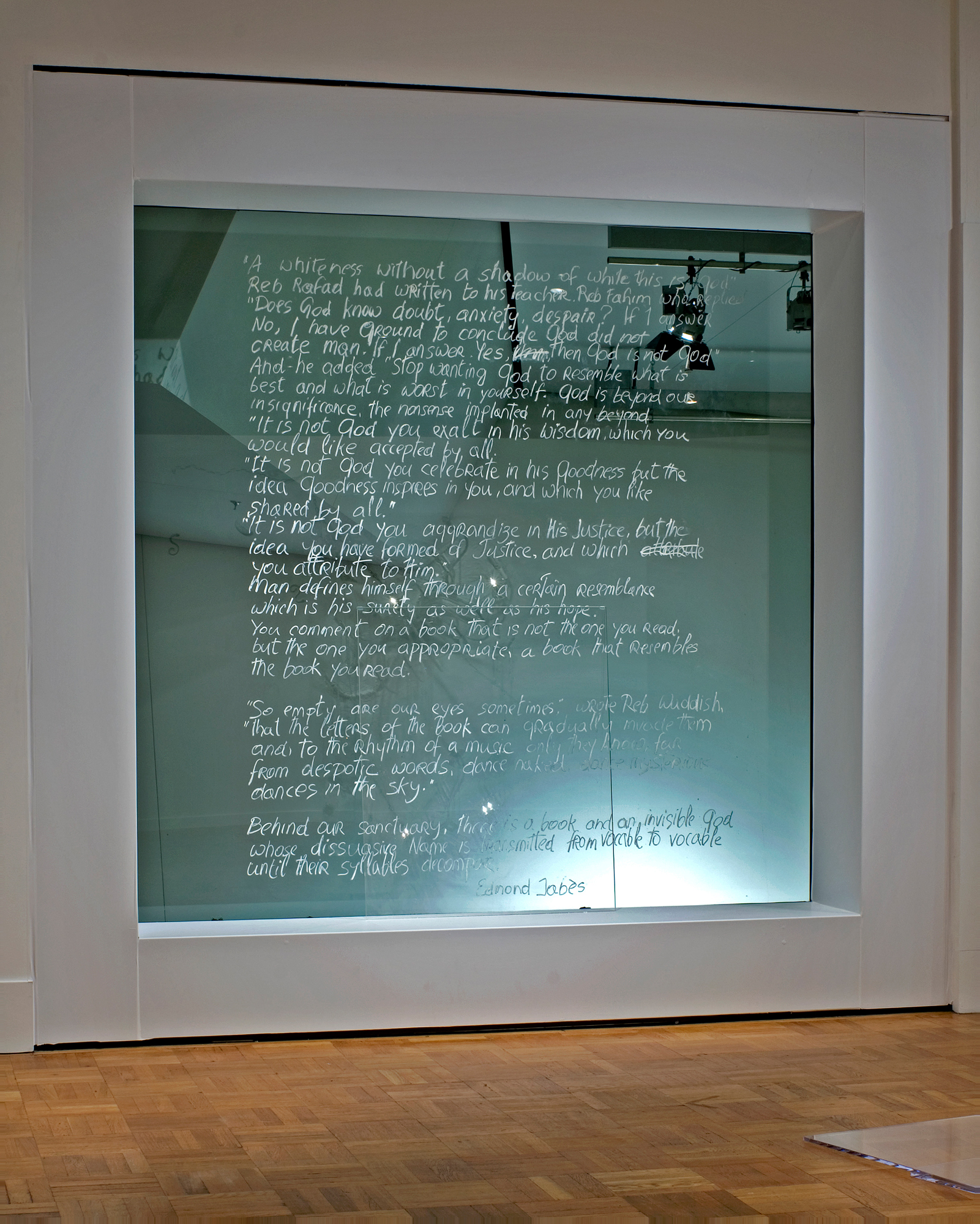JOSHUA NEUSTEIN
MARGINS: CONTEMPORARY ART UNRAVELING THE DEAD SEA SCROLLS


Exhibition
Koffler Gallery at the Institute for Contemporary Culture, 2009–2010
Photo documentation by Isaac Applebaum
Margins is a new installation by Joshua Neustein commissioned in conjunction with the concurrent exhibition, Dead Sea Scrolls: Words that Changed the World. Shaping a dialogue with the Scrolls, Neustein’s project engages in a poetic reflection on writing, religion and archaeology. These notions are approached with mistrust for dogmas and with an intellectual yearning for re-interpreting inherited assumptions.
Positioning the themes of the Scrolls within a contemporary discussion about cultural traditions, Margins references prominent Jewish poet Edmond Jabès (Cairo, 1912 – Paris, 1991) and his critical works concerned with the nature of writing, silence, God, and the Book. Neustein recognizes in Jabès’s relationship to writing a parallel to his own artistic process. Living and creating between countries and languages, both artists express themselves from a position of displacement. Instead of a sense of belonging to a land, they both trace their roots to a deeper connection to the word and to a tradition of reading and questioning the Book. In the installation, Jabès’s mysterious meditations and the revealed knowledge of the historical texts converge with Neustein’s own visual vocabulary to convey the passion and impossibility of writing.


Through drawing, sculptural and textual elements, Neustein’s piece re-enacts the emergence of the word piercing the silence with luminous presence. The sumptuous chandelier embedded into the gallery wall radiates as the core of the work — a strange archaeological relic excavated into visibility. Unraveling towards the chandelier’s brightness, transparent acrylic sheets lay collapsed on the floor, bearing shimmering texts. Drawn out by light, handwriting turns into typography, setting words into crystallized form. This script escapes the page, crossing margins into the space where writing struggles to uncover what is not yet written.
As another element in the installation, Neustein’s successive gestures of drawing and erasing on a bare wall attempt to recover the blank slate. Instead, the act of erasure reveals the resilient memory of marks, even as the artist attempts to recover the potential of the empty surface. Archaeology unearths dormant traces of history, while writing pushes at the edge of silence to bring forth the unsaid. Similarly, Margins explores apparent and concealed ideas of the Dead Sea Scrolls, exposing them to the light of our times.
As another element in the installation, Neustein’s successive gestures of drawing and erasing on a bare wall attempt to recover the blank slate. Instead, the act of erasure reveals the resilient memory of marks, even as the artist attempts to recover the potential of the empty surface. Archaeology unearths dormant traces of history, while writing pushes at the edge of silence to bring forth the unsaid. Similarly, Margins explores apparent and concealed ideas of the Dead Sea Scrolls, exposing them to the light of our times.





Artist Info
Joshua Neustein was born in Poland in 1940 and currently lives and works in New York. He is known primarily for his installations that create a total environment to enter and experience, as well as his Post-Minimalist paper works and large-scale map paintings. After immigrating to Israel in 1964, Neustein made a significant impact and is considered one of the founding figures of Environmental and Conceptual Art into the local cultural scene.
Over the years, Neustein has developed a distinctive visual language of characteristic materials and symbolic motifs. Since 1991 when the piece entitled How History Became Geography was presented at the Barbican Arts Centre (London, England), the chandelier has played a central role in many of his installations and has been a continuous presence in later works including Light on the Ashes (1996, SECCA, Winston-Salem, North Carolina), Aschenbach (1997, Martin-Gropius-Bau, Berlin, Germany), and Domestic Tranquility (1999-2000, Herzliya Museum, Israel. Emblematic of enlightenment, this object alludes to a striving for discovery and interpretation, while offering an indispensable counterpart to the obliterating darkness of Neustein’s other essential materials: soot and ash.
Another constant in Neustein’s body of work is an engagement with text and its inherent archival nature. In 1995, Neustein represented Israel at the Venice Biennale with a monumental intervention that engaged with the contents of the Israeli National Archives, which were transferred to Italy for this project. The complex installation entitled The Possessed Library, employed many of Neustein’s trademark materials, notably glass and soot, playing off of their respective transparency and opaqueness. The work examined the essential links between the Jewish people and the Book.
Neustein has exhibited in museums and galleries around the world including the Chelsea Art Museum (New York), The Jewish Museum (New York), Mary Boone Gallery (New York), The Israel Museum (Jerusalem), Albright Knox Gallery (Buffalo, New York), Los Angeles County Museum of Art (Los Angeles, California), MOCA (Los Angeles, California), MAK (Vienna, Austria), Museu D'Art Contemporani, (Barcelona, Spain), Museum of Contemporary Art (Tokyo, Japan), The Rose Art Museum (Waltham, Massachusetts), Tel Aviv Museum of Art (Israel), and Zacheta National Gallery of Art (Warsaw, Poland).

